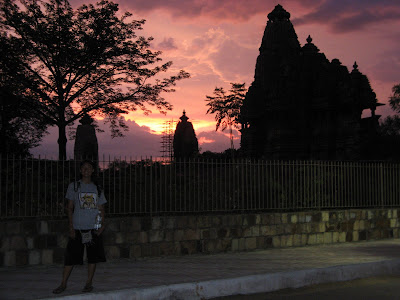We took the river boat ride early in the morning. We saw people bathing, washing clothes and utensils and performing ritual by the river. Just beside of the burning ghat, they were people doing dhoby. There were even people sieving beside of the burning ghat in hope to find some small jewelleries from the ashes in the river.
When we walked in the small alleys of Old Varanasi, there were many times that we would bump into some 'untouchable' carrying the deceased towards the burning ghat. Growing up in a city so closed to death, the people here were probably very familiar and 'unmoved' with death.
i don't like this holy city. Besides from the 'holy' name, this place, including people and the street are dirty. The small streets were very narrow and always full with dung and rubbish. Walking in such a small street, i felt every dirt was just so closed to me. As long as you are tourist, there will always somebody there to either ask you to buy something or even endeavoured to cheat you. The rubbish floating on the Ganges and the waste water was channeled into the river as well. i couldn't relate this place with "holy". i couldn't stand here, so i decided to set off to Sarnath.
Dario and Eneko decided to stay for another day. So we did the last sight seeing together, the millitary guarded Golden Temple (Vishwanath Temple). The Hindu and Muslim have been killing each other for years to get this piece of temple/mosque holy ground. You torned down my mosque to build temple and i would do the same to your temple. This piece of land was nothing impressive at all, except for the heavy millitary. We were not allowed to bring anything, including beg and camera to enter the place.
The journey to Sarnath was unbelievable smooth with friendly and helpful Indians. The guest house ran by the monastery of Trangu Rinpoche was the best i ever had in India. Very clean and big. i could even eat with the monk in the canteen. The place is serene and quiet, in the middle of a village. The Rinpoche was in Hong Kong, so i didn't have such a good kamma to visit him. A young man, Tsering, who speaks better English attended to me.
Sarnath was my first buddhist pilgrim site, the place where buddha gave his first sermon.
i had a quiet and peaceful sleep.

The morning by Ganges River. People were doing cleaning despite the condition of the river. :)
Varanasi, the city of Shiva was previously called Benares and Kashi (City of Life). Hindu pilgrims come wash away all their sins in the Ganges.

This was about 6am in the morning and the river is bathed in a mellow lights.
A meditator by the holy river.

My morning puja.

The burning ghat, Manikarnika Ghat.
The tourists are not allowed to take the burning picture in respect to the deceased and the family.

The temples and guesthouses by the western bank of the river.

The dhobi ghat.

The women were washing away their sins in the Ganges.













































